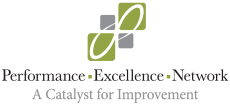
Good Leadership: Part Process, Part Proficiency — Mar 2023
March 22, 2023
Last week I had the privilege to visit with an undergrad class at St. Lawrence University in Upstate New York about best practices in leadership and management. So, I figured if the conversation was valuable enough for a couple dozen college students (who are young & emerging leaders), maybe it would be worth sharing with our network of thousands of organizational and community leaders!
My central theme was this: good leadership is the result of both good leadership process and good leadership proficiency – a combination of traits, characteristics, competencies (which, quite honestly, are also the result of having good leadership processes to develop that proficiency!). There, you have the punchline. But let me elaborate and let’s explore how it might benefit your own leadership capabilities…
I first asked the students what — in their minds — facilitates and ensures excellence within organizations. Most of them had jobs in high school or college (and I’m sure all of them have purchased their share of Starbucks coffees, movie tickets, or whatever online!), so they’ve been exposed to good and not-so-good businesses and organizations. I got all sorts of (valid) answers like: superior customer service; a motivated, committed team; good communication; having a vision and goals. Excellent answers, by the way.
I then asked them what they thought was the most important driver of excellence. After the requisite five seconds of silence, some brave student mentioned something — I can’t remember what it was, but let’s say it was providing solid customer service. Then another chimed in and said “yeah, the customer is important, but without a motivated, committed team, you can’t provide great customer service.” Then another said that maybe having a vision and goals was the most important, because without direction, you’ll never know if you’re making progress. I guess you see my point: the answers ended up being about the same as the with the first question – all of these things were important to ensuring high performance.
In reality, there are probably two correct answers. First, it depends! It really does, because no two organizations are exactly alike, even from within the same industry: organizations have different core competencies, different workforce cultures, are pursuing different strategies, operate in different markets or in different environments. So what drives excellence in one organization is usually a little different than what drives it in another. And the second “correct” answer? Strong leadership. There’s a great deal of research that demonstrates the correlation between good leadership and good organizational performance: in fact, effective leadership is the number one predictor of positive results.
So that’s when I introduced the Baldrige Framework to the class: Baldrige is an evidence-based leadership & management system that optimizes resources, facilitates organizational alignment, and improves outcomes. If you’re not fully familiar, the Baldrige Framework is revised every two years to reflect what the best-in-class are doing to achieve high performance, so in this way, serves as validated set of best practices against which any organization can gauge their own performance to identify and prioritize organizational strengths and improvement opportunities. (If you’re interested in learning more about Baldrige — its history, value, application and use — check out my blog from a couple of years ago here.)
So this is the point in the conversation where I revealed my first key insight to the class: good leadership is a process.
Processes (according to the Baldrige glossary) are a set of “linked activities with the purpose of producing a product (or a service or a program) for a customer within or outside an organization.” With that as a definition, pretty much everything in an organization is a process (or should be), from how you make decisions, to how you set plans and goals, to how you recruit and hire, to how you build relationships with customers, and certainly to how you lead.
In fact, the Baldrige Framework is a collection of about 270 questions, each one representing a process — of how an organization or community systematically takes input(s) and converts them to output(s) of value to a customer. Category 1 in Baldrige is Leadership, so it stands that the roughly 40 questions (there are actually 43!) in that category represent best practices in an organization’s leadership system. Here are some of those leadership processes (I’ll spare you and not list all 43!):
- Setting organizational mission, vision and values
- Creating an environment that ensures a successful organization now and in the future – leadership activities such as creating and reinforcing a high performance and inclusive culture, cultivating organizational agility and resilience, facilitating learning and innovation
- Participating in succession planning and the development of future leaders
- Promoting, ensuring, and demonstrating legal and ethical behavior
- Communicating with and engaging the entire workforce and key customers
- Creating a focus on action that leads to achieving the organization’s mission: setting clear expectations, demonstrating personal (and facilitating team) accountability
- Ensuring responsible governance, transparency, and the protection of stakeholder interests
- Evaluating and improving individual leader effectiveness as well as effectiveness of the leadership system itself
- Anticipating and addressing public concerns
- Actively supporting and strengthening key communities and incorporating societal well-being into strategy and daily operations.
The class and I had a great conversation about how those questions could each be converted into a process (or a collection of processes), and how each of those processes needs to be systematic (that is, consistent, repeatable, and inclusive of data so that learning and improvement can take place).
Which is when I revealed my second key insight to the class: leadership processes are required to ensure effective leadership, but leadership is also a uniquely human skill — a set of characteristics, traits, and competencies that separate the good from the bad leaders (and the great from the good).
Think about any manager you’ve reported to in your career: of the “best” ones, what made him or her so effective? I’m guessing they had high levels of integrity and ethics. I’m also guessing they held people accountable, empowered their team, embraced learning (both professional and organizational), were civil (respectful, maybe even kind) and truly authentic (they are genuine, “real,” down-to-earth). Simply put, good leaders are just good people who care greatly for the success of their team.
A few years ago, one of my other monthly blog articles focused on common leadership traits that the best leaders usually have. I analyzed several independent studies (published in Harvard Business Review, Forbes, CEO.com, and other sources). Somewhat amazingly, there was a high degree of correlation: in fact, there were nine leadership traits common across all of these studies. Good leaders:
- Practice civility
- Have integrity
- Are conscientious and accountable
- Show vulnerability
- Communicate effectively
- Empower their people
- Embrace learning
- Are authentic
- Serve others
That’s a pretty powerful list, and I’d invite anyone to argue with any of the nine (if you’re interested in that original blog, visit here).
In driving home the point that good leaders have a set of somewhat universal characteristics and traits, I showed the class a 90 second video of Simon Sinek from a few years ago, in which he explores what makes a true servant leader (if you’re interested in the video, visit here). In the clip (and in his book “Leaders Eat Last”), Sinek suggests that leaders need to place themselves second to their teams, as it creates an environment of trust and cooperation.
According to Sinek: “…when the people in the organization believe to the core of their being that their leader would soon as satisfy their own interests to take care of them and their growth, the natural, biological response is trust and cooperation. However, if the people believe to the core of their being that the leader would sacrifice them to protect their own interests — using layoffs so that they can maintain their bonus or meet some arbitrary projection, for example — the natural, biological reaction to that kind of behavior is cynicism, paranoia, mistrust, and self-interest. In other words, you get the culture that you build, and leaders are responsible for building the culture.”
Sinek goes on to say that just like a parent feeds their children before they feed themselves (while a bad parent neglects the needs of their kids in favor of their own self-interests), “…a good leader is exactly like a good parent: they want to see those around them grow, build self-confidence, skills, discipline them when necessary — all so that they can achieve more than whatever we could have dreamed for ourself. And the response is a deeply trusting, wonderful loving relationship.”
So effective leadership is a process, but it’s also about proficiency — having a set of characteristics, traits, and skills that are desired and appreciated by others. And that’s when I revealed a third and final key insight for the class’s consideration: one leads to the other! Sure, some leaders seem to be born with the capability to lead, but most need practice — they need training, coaching, feedback, ongoing repetition, which are all processes themselves! As a result, organizations should build processes to find, recruit, develop, nurture, reward, and promote their current and future leaders. I believe leaders can be taught to be more civil; leaders can be taught to set high expectations and hold their team accountable; leaders can be taught to empower and delegate; leaders can be taught to serve. Over time, leaders can develop leadership proficiency, honing those nine traits, characteristics, competencies.
If you want to discover and explore ways to improve your own leadership (and/or help those on your team develop theirs), consider attending the PENworks 2023 conference May 4 (in person in the Twin Cities and streaming live, online across the country, globe!). The conference will feature about 20 local, regional, and national leaders, each sharing insights, tools, methods, and best practices that will improve leadership, focus on customer, workforce engagement (and, yes, ideas to address the current staffing crisis), innovation, partnerships, equity and inclusion, and many, many more key areas of organizational and community performance! The conference will offer great learning, great networking, and great energy to start, continue, or accelerate your journey to excellence. So invest in your own leadership (and that of your team!). After all, leadership is a process. More information is here.
Also, consider one of the two pre-conference workshops (even if you can’t attend the main conference):
- Tips to Build a World-Class Workplace, facilitated by Dr. Bryan Williams or
- Building DEI into Core Operations, facilitated by three leading DEI experts.
Both workshops are May 3 afternoon (1-5pm CT) and can be viewed as a pre-conference workshop or just a stand-alone experience.
I hope to see you all in May!
What other insights/tips do you have on effective leadership? Participate in a discussion on this topic: visit our LinkedIn group to post a comment.
Never stop improving!
Brian S. Lassiter
President, Performance Excellence Network
www.performanceexcellencenetwork.org
http://twitter.com/LassiterBrian
A Catalyst for Success Since 1987!
Photo credit: Gossling, Baldrige Performance Excellence Program, YouTube, ATD






